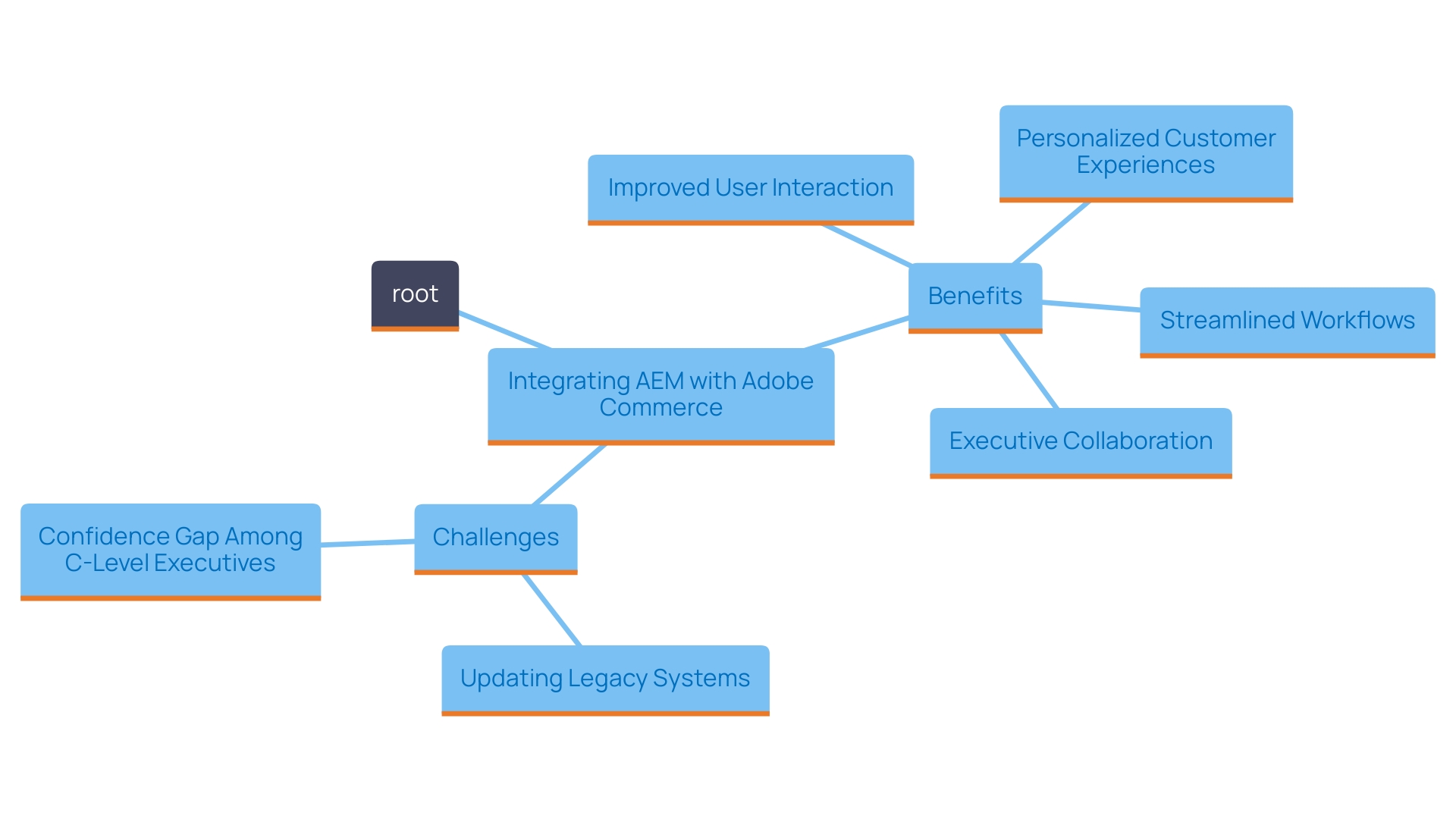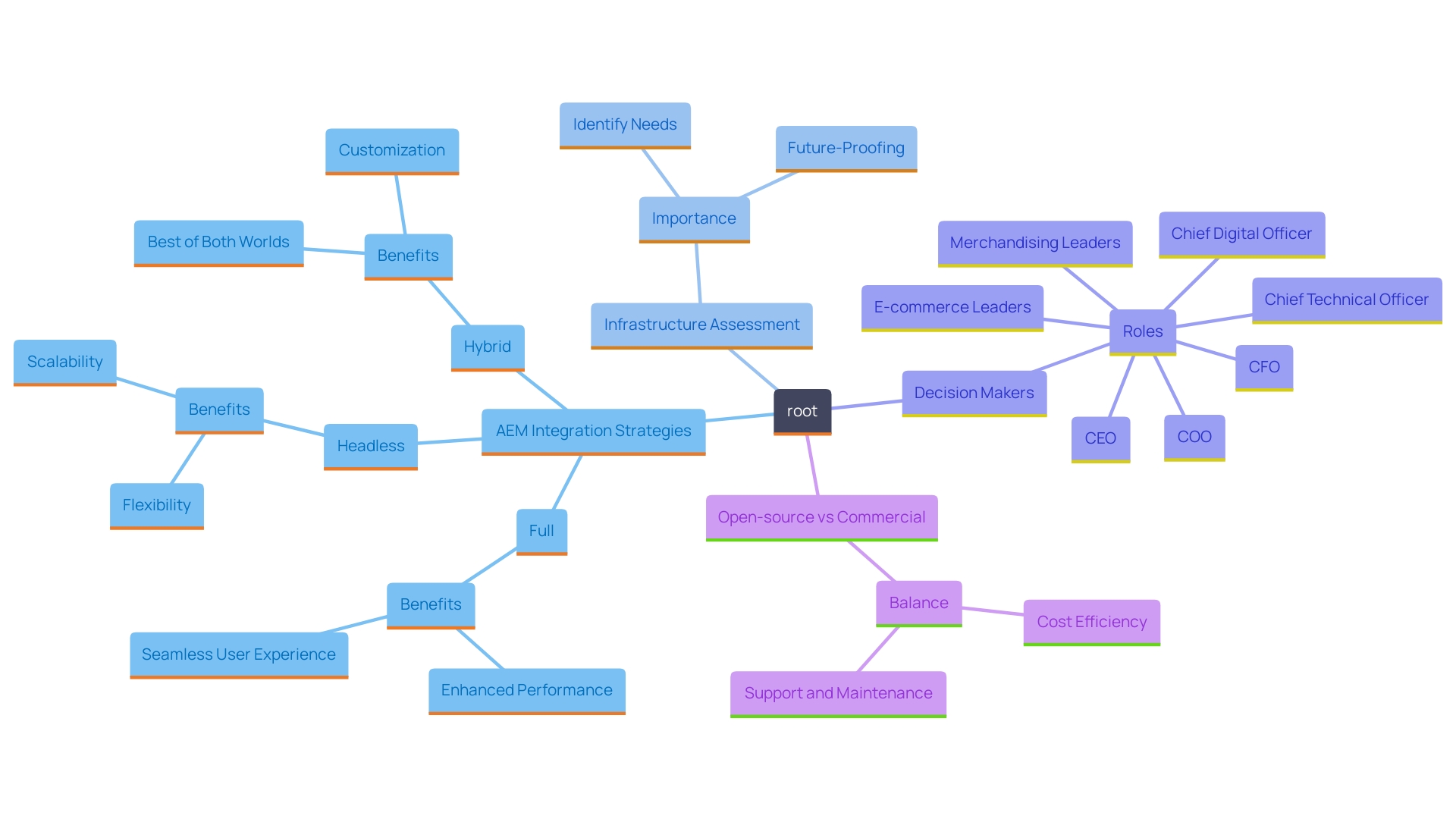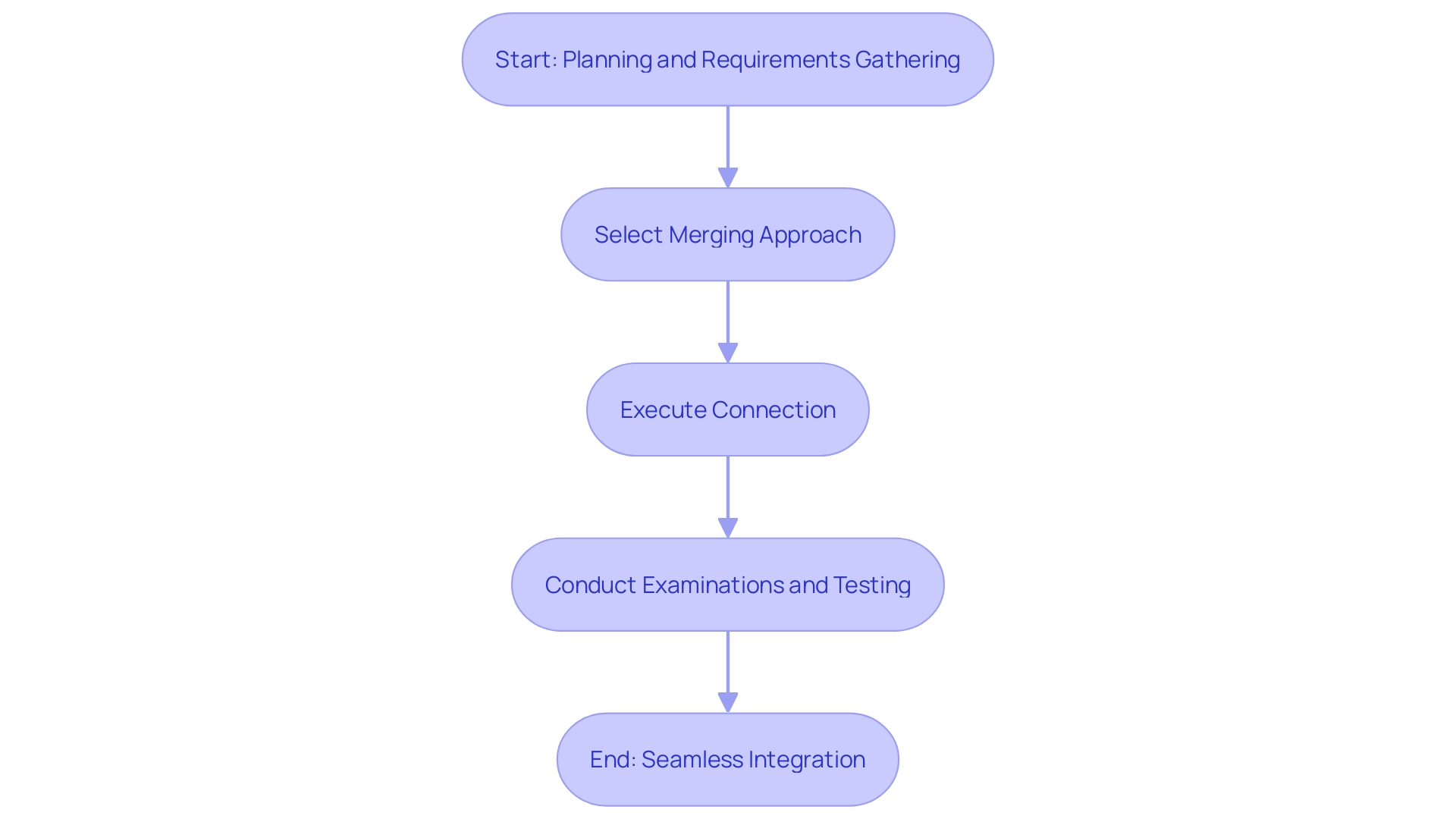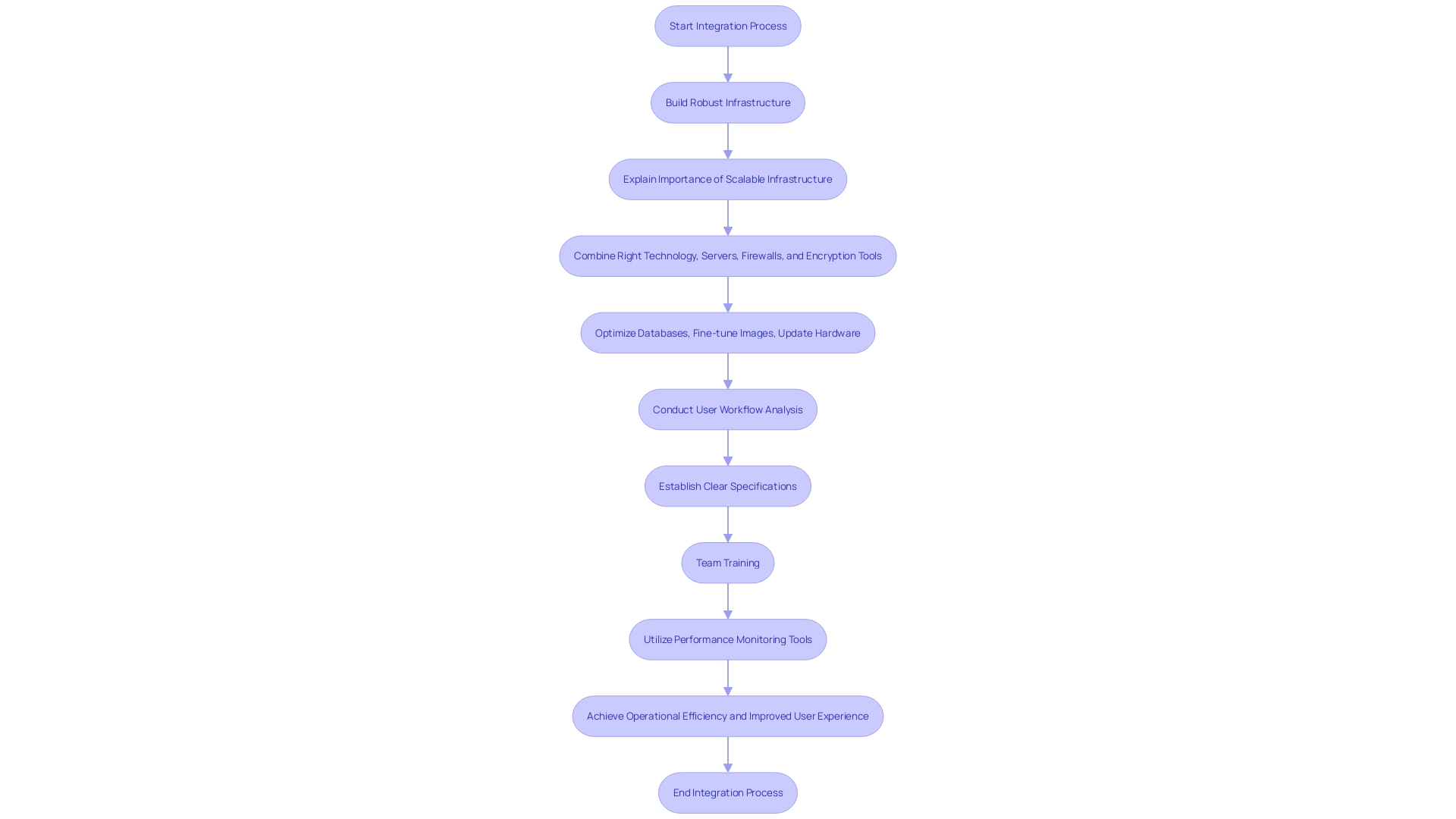Introduction
The integration of Adobe Experience Manager (AEM) with Adobe Commerce is transforming the landscape of digital commerce, creating an unparalleled synergy that elevates user experiences while streamlining operational efficiencies. As businesses strive to provide personalized interactions and seamless omnichannel solutions, the necessity for unified commerce becomes increasingly evident. This article delves into the myriad benefits of this powerful integration, highlighting the importance of strategic alignment among C-level executives to navigate the challenges posed by legacy systems.
It will explore various integration approaches tailored to diverse organizational needs and offer a comprehensive roadmap for successful implementation. By examining critical steps and essential considerations, this discussion aims to equip businesses with the insights needed to leverage this integration effectively, thereby enhancing their competitive edge in a rapidly evolving digital environment.
Benefits of Integrating AEM with Adobe Commerce
Combining AEM with Adobe Commerce forms a strong synergy that improves the overall user interaction by providing rich content alongside robust e-commerce functionalities. This combination is particularly vital for businesses aiming to personalize customer interactions. Data indicates that unified commerce is increasingly essential for retailers, as it provides a single, real-time inventory view across multiple platforms. Such visibility allows customers to enjoy seamless omnichannel experiences, such as shopping in-store and arranging for home delivery or easily making returns regardless of the purchase channel.
Furthermore, this combination simplifies workflows by consolidating content management and e-commerce operations into a unified system, significantly enhancing operational efficiency. Companies like Dunelm Group plc, which attracts over 400 million sessions annually and generates about 35% of its revenue online, exemplify the benefits of such integrations. As organizations grow, aligning technical architecture with organizational needs becomes critical. They often face the challenge of updating legacy systems to support this growth. Collaborative efforts among C-level executives—ranging from the CEO to the chief digital officer—are essential for overcoming these hurdles. However, reports indicate that while C-level executives may have high ambitions for unified commerce, they often lack confidence in their existing strategies and tools to achieve these goals.
By centralizing operations through AEM and Adobe Commerce, organizations can not only enhance their personalization capabilities but also reduce time-to-market for their campaigns, positioning themselves to better meet evolving customer expectations.

Choosing the Right Integration Approach
Combining AEM with Adobe Commerce requires a thorough assessment of different connection strategies, including full, headless, and hybrid models. Each option presents unique benefits tailored to diverse business requirements, technical proficiency, and future aspirations. For example, Dunelm Group plc, the UK's leading homewares retailer, relies on a robust digital platform that generates approximately 35% of its revenue from over 400 million annual website sessions. This impressive performance highlights the importance of choosing a method that aligns with growth trajectories and operational frameworks.
When contemplating integration, organizations must assess their existing infrastructure and scalability needs. As companies expand, it becomes vital to adapt their architectural frameworks to support increased traffic and transactions. 'The trend towards microservices in backend architecture illustrates a shift towards more flexible and resilient structures.'. However, the frontend layer also requires consideration, especially for high-revenue-generating businesses.
The intricacies of attaining a cohesive commerce experience are often worsened by outdated infrastructures that require updates. Successful unification relies on teamwork among a varied group of decision-makers, from C-level executives to e-commerce leaders. Data indicates that while C-level executives typically harbor ambitious goals, they often lack the strategies and tools required to realize them. In contrast, senior executives reporting directly to the C-suite exhibit greater confidence in their capacity to meet unified commerce objectives, reflecting a disparity in ambition and preparedness.
Furthermore, the evolving landscape of enterprise software introduces a blend of open-source and commercial solutions. Organizations are increasingly evaluating the true costs associated with these options, weighing the benefits of commercial support against the lower upfront costs of open-source alternatives. As William McKnight emphasizes, understanding this balance is crucial for developing a sustainable information management plan.
In today's interconnected digital landscape, tailored connections using Software Development Kits (SDKs) and REST APIs play a crucial role in bridging functionality gaps between disparate systems. As Mike Sedzielewski observes, the incorporation of APIs can significantly boost operational efficiency, enabling companies to streamline processes and enhance user experiences. Ultimately, the selection of merging approach should reflect an organization's unique needs and strategic objectives, enabling them to capitalize on emerging opportunities in the dynamic e-commerce landscape.

Steps for a Successful Integration
Integrating AEM with Adobe Commerce requires meticulous attention to several critical steps to ensure a seamless and effective implementation. Initially, it's vital to engage in comprehensive planning and requirements gathering. This phase ensures that stakeholders from various levels of the organization, including executives and technical teams, are aligned on the unification objectives. With over 400 million sessions on Dunelm's website and significant revenue generated from their digital platform, the importance of this alignment cannot be overstated.
After the planning stage, organizations must choose the suitable merging approach based on previous evaluations. This decision is pivotal, as it sets the foundation for the development and configuration stages. The technical teams should then execute the selected connection approach, considering the necessity for a sturdy e-commerce framework. Given the dynamic nature of online commerce, businesses must adopt frameworks that can adapt to ever-evolving demands and fortify against cybersecurity threats.
Later, thorough examination is crucial to confirm that the combination meets all functional and performance expectations. This step is particularly important in the context of a unified commerce approach, which often faces challenges due to existing legacy systems. Effective unification will not only improve the overall online shopping process but will also enable organizations to utilize their data more efficiently, resulting in informed decision-making and better customer interaction. As Akamai emphasizes, embracing cloud computing and integrating secure solutions can revolutionize the online shopping experience, making the testing phase a critical component of achieving long-term success.

Essential Considerations for a Successful Integration
Successful combination of e-commerce platforms requires careful attention to several key factors. First, efficient data synchronization between AEM and Adobe Commerce is crucial to ensure a seamless flow of information. This not only preserves uniformity across networks but also boosts operational efficiency. Conducting thorough analysis of user workflows can uncover essential data requirements. For instance, watching how team members engage with both platforms can uncover areas where they might be repeating tasks, like copying and pasting information, which could be optimized through unification.
Training is another vital consideration; equipping your team with the knowledge and skills necessary to navigate new systems can lead to smoother transitions and improved performance. As emphasized in recent conversations regarding software combination projects, starting with a clearly outlined specification is essential. This foundational step enables organizations to align their goals and expectations, ultimately leading to a more effective unification process.
Performance monitoring tools are also essential for evaluating the effect on website stability and user experience. Utilizing these tools allows for the identification of potential issues in real-time, enabling timely adjustments that can enhance site performance. As the e-commerce landscape continues to evolve, leveraging a robust data integration strategy is more important than ever for maintaining competitive advantage.

Conclusion
The integration of Adobe Experience Manager (AEM) with Adobe Commerce offers a multitude of benefits that significantly enhance user experience and operational efficiency. By unifying content management and e-commerce functionalities, businesses can deliver personalized interactions and seamless omnichannel solutions. Real-time inventory visibility ensures that customers can engage with brands across various platforms, whether shopping in-store or online.
This streamlined approach not only improves customer satisfaction but also reduces time-to-market for campaigns, allowing businesses to adapt quickly to changing market demands.
Choosing the right integration approach is crucial for aligning with organizational goals and technical capabilities. Options such as full integration, headless, and hybrid models cater to different business needs and scalability requirements. As companies grow, adapting their architectural frameworks becomes essential to support increased traffic and transactions.
The shift towards microservices and custom integrations highlights the importance of flexibility and resilience in today’s digital landscape. Collaborative efforts among C-level executives and technical teams are necessary to navigate the complexities of integration and to ensure that ambitious goals are met with effective strategies.
Successful implementation of this integration requires meticulous planning, method selection, and rigorous testing. Engaging all stakeholders early on helps align objectives and establishes a strong foundation for development. A focus on data synchronization, team training, and performance monitoring will further enhance the integration process, ensuring that businesses can leverage their systems effectively.
As the e-commerce environment continues to evolve, adopting a robust data integration strategy will be pivotal for maintaining competitive advantage and achieving long-term success.





